The Art Of Decluttering
That jumble of clothes in your closet or stack of mail in your mudroom isn’t just an eyesore. Physical clutter in your home can have a direct impact on your overall well-being. You might not be a “clean freak,” but keeping things neat and tidy around the house is a big deal: it reduces stress levels, helps fight depression, makes it easier to focus, leads to better eating and improves air quality.
Clutter can be described as: anything you’re keeping that doesn’t add value to your life. Decluttering is all about making room in your home for the things that truly matter. Clearing out unwanted and unnecessary “stuff” can help you get that healthier, happier home feeling.
When it comes to decluttering your home, the hardest part is often just figuring out where to start. Decluttering might sound easy enough in theory until it comes time to actually get started. Then you may find that there’s a reason you’ve been putting it off for this long. Start small, and make your way slowly—remember doing too much, too fast can get overwhelming, causing you to push the chore off longer. Many people find it easier to reduce clutter by devoting 15 minutes a day to the task, as opposed to setting aside an entire day or weekend and making a marathon out of it.
Simplifying doesn’t mean sparse or boring. The opposite is true. With fewer mess and distractions, your home can become more peaceful. You can view your home as a space for rest and comfort, instead of a source of stress. So, take a deep breathe and prepare to declutter your home, and make room for all the new year has to offer you and your family. Remember, no matter how much it may have cost originally, if it’s not adding any value to your life, it’s not valuable.
Assess The Situation
- Make a list of all the areas of your home to be decluttered.
- Decide how much time you’re going to commit to decluttering & stick with it.
- Set up 4 boxes to put your unneeded clutter in and label them “Recycle,” “Donate,” “Sell,” and “Trash.”
- Make it fun! Turn up the music, use the timer as a count down and see how much you can accomplish in a classic game show style!
Start With The Entryway
Start at the door where the family usually enters, and create places for the clutter to land before it reaches the rest of the house. Set up a paper recycling center and specific places to put mail, backpacks, shoes, and homework. Then work your way around the house, decluttering and creating designated destinations within each space for everyday necessities.

Bedrooms
Its functions are simple yet imperative – sleep, relaxation, and rejuvenation. The last thing you want is it to be a space of stress. However, through the hustle and bustle of life it’s common for the bedroom to become a dumping ground for unfolded laundry, unpacked bags and miscellaneous items.
First, make your bed. It’s hard to feel any progress decluttering a bedroom while an unmade bed stares you down. As you make it, consider each layer of bedding. Discard any layers or accessories that don’t add to your comfort while in bed. If the beauty of the plethora of throw pillows doesn’t outweigh their annoyance of tossing them on and off the bed twice a day, get rid of them. You probably don’t consider your bed to be a contributing factor to your bedroom’s clutter problem, but you’ll immediately notice the difference a clear bed can offer your room. Not only will it give you a sigh of relief but it can now double as a surface to place items as you work your way around the room. Being able to see everything laid out in front of you will give you a better idea of what to keep and what to toss. Look under your bed and see if there is anything that can be properly put in place, such as clothes, shoes, books, pet toys or other easy-to-escape items.
Next, clear off all surfaces. Flat surfaces (nightstands, dressers, shelves) tend to become clutter magnets, and things can quickly and easily pile up. Nothing says clutter like the collection of small trinkets and old candles collecting dust. Throw away anything that does not enhance the piece of furniture, or the room overall. Be very selective about what you choose to put back on the surfaces in your bedroom. Prioritize the items you use daily during your nightly or morning routine and discard of anything taking up unwanted space. Find or make a home for anything you want to keep to make sure it won’t end up cluttering those surfaces again.
Don’t forget to go through and organize the drawers in your nightstands and dressers. Assign each drawer a purpose and group like items together as you put items back.
Place dirty clothes and linens in the hamper, and return any clean clothes to the closet.
Finally, tackle the bigger items. Is that vintage chair in the corner holding its purpose? Do you use it to relax and rewind? Drink a cup of coffee in the morning? Or is it a stockpile for clothes. If the intended purpose of the furniture is being used, it’s adding value to your life. However, if it’s a clutter collector, it may be time to donate it and say good bye.
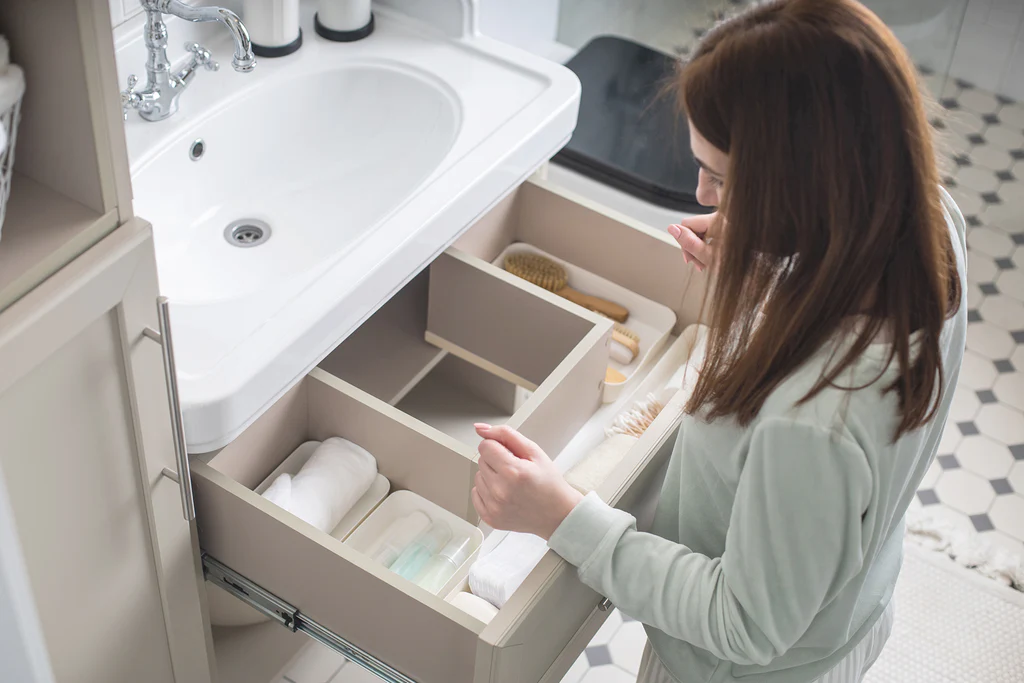
Bathrooms
Bathrooms are the smallest rooms in any home, and they’re also usually the messiest. Between the linens, toiletries, medications, cosmetics, hygiene items and cleaning supplies, it’s all too easy to let the products that keep you clean and presentable stockpile on your countertops or in your cabinets. You can usually make more rational decluttering decisions about the stuff in your bathroom simply because decluttering your bathroom is usually more a matter of clearing out unused, unneeded, unwanted and/or out of date products and items, rather than deciding what to do with sentimental items or things you’re emotionally attached to.
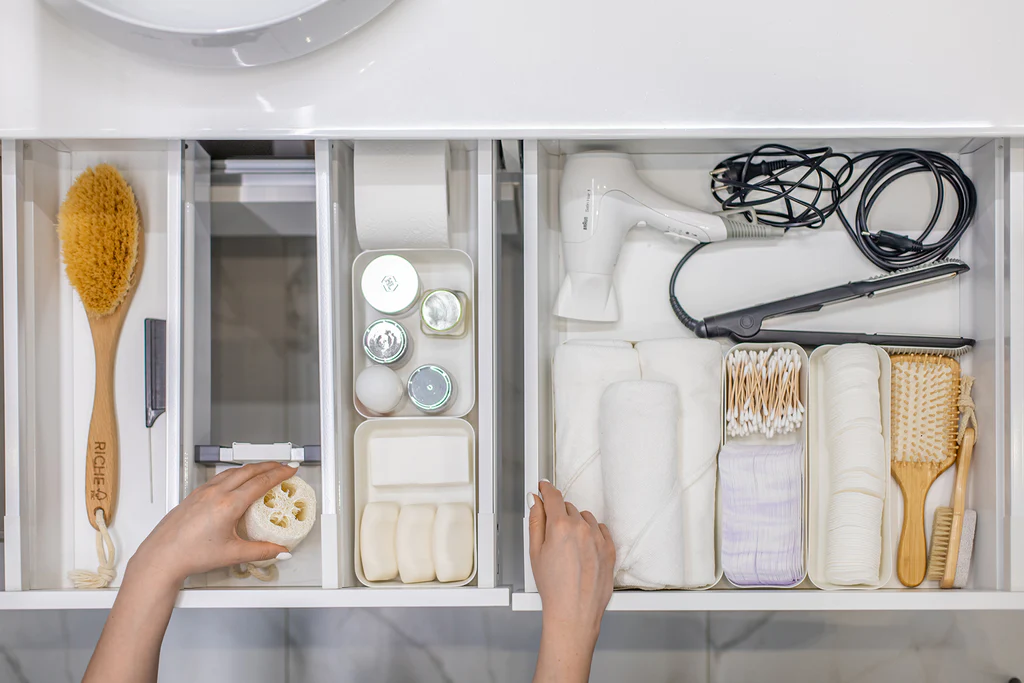
Gather up all the items in your bathroom and sort them into categories, putting like items together. For example, gather all your nail polish, all your lotions, all your hair tools, etc. Putting like items together in piles. Decluttering by category makes it easier to see how much stuff you have in each category and help you be more ruthless as you decide what to keep and what to get rid of. Toss any expired medicines, makeup and personal care products. Toss items such as bottles of hair products that you don’t use or like. Also look for duplicate products you don’t use, need or want.
Separate out the stuff you do use each day (toothbrush, toothpaste, deodorant, etc.) from the stuff you don’t (first aid products, sunscreen) and find a new home in a linen closet to store the second group. Also try to only store enough towels for each bathroom and don’t keep extras in there if possible.
A simple way to help your bathroom look, feel and function better is by keeping your counters completely clear or only keeping the essentials out on your counters. Then find homes for everything else in cabinets or drawers. Clutter-free countertops not only give you more room to use as you get ready for the day. But they also make it so much easier to clean your bathroom and keep it clean too.
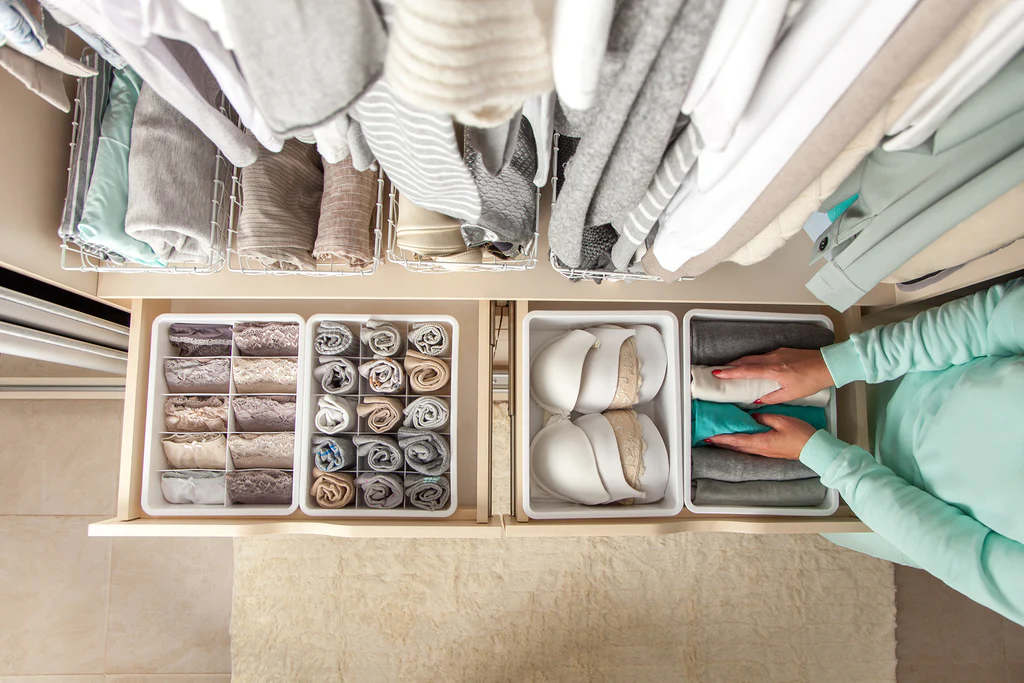
Closets
If you’re looking for the biggest clutter culprit in most bedrooms, look no further than the closet. Even if it’s often behind closed doors, the closet is often teeming with clutter in the form of clothes you no longer wear and those that never got back onto the right hanger or into the correct stack on the shelf.
First, keep the closet a space only for clothing, accessories and shoes. It’s easy to use the room as a safe haven for storage, however, it’s imperative to remove anything that is not an article of clothing. Clothes can be tricky to declutter for many of us. But do your best to be as ruthless as you can with clothes you don’t love or wear. A key question to ask yourself with each individual piece of clothing is, “Would I buy it again?” If the answer is no, it’s time to discard it in the appropriate box. Try not to get stuck in the sentimental value of every single piece of clothing from a specific time in your life, instead, ask your self, “Do I need to hold on to this”. If the answer is yes, try and understand why you feel that way.
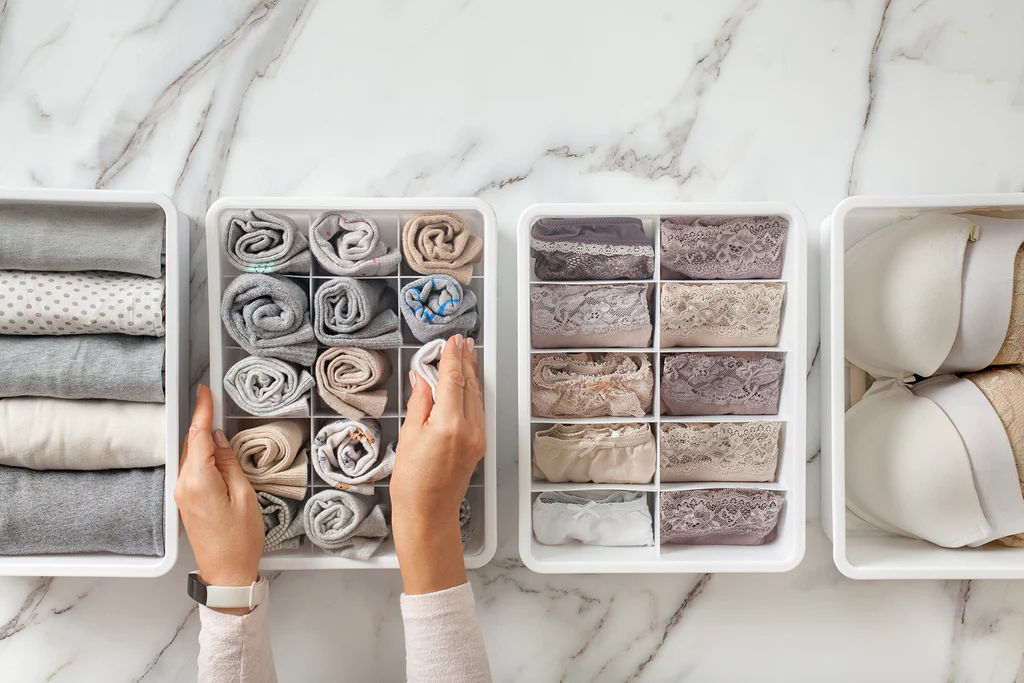
Next, designate a place for everything in your closet. From color order, the type of garment, to frequency there are many ways to sort your clothing. You know you best so we recommend choosing the order that makes most sense to you and your daily life. Shoes in one place, sweaters in another, and so on. This will help you keep order and save time each morning. One easy way to start this process is to get the shoes off the floor. Adding a simple shoe rack or shelf can clear up a magnitude of floor space, transforming your closet. While you go through your collection of shoes throw away any pairs you have not worn in the last 6 months. It’s safe to say you probably won’t wear them again.
Put away out-of-season clothing. If it’s winter, pack up your beach wear. If it’s summer, say goodbye to the snow-pants and sweaters for a while. Using old suitcases is a great way to easily store and keep unwanted clothing out of the closet. Next, with this new found space find a spot for your laundry bin. The days of dirty laundry piles growing high are over. This simple and innovative change will help you keep your new decluttered closet clean and organized everyday.
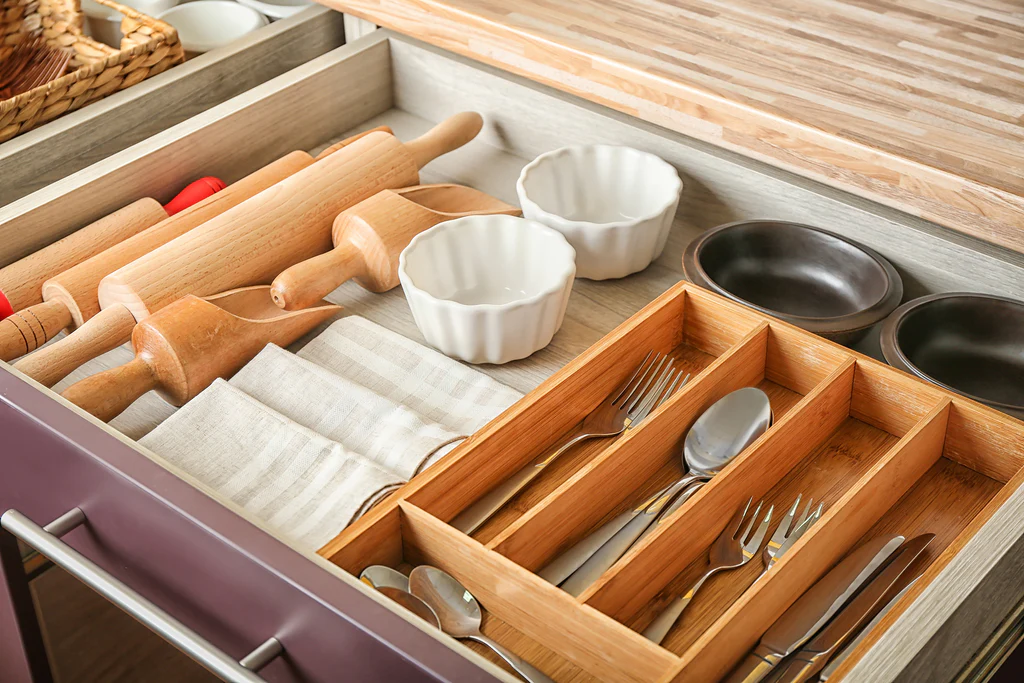
The Kitchen
From those disheveled pots and pans, to the leftover takeout condiment packets and random silverware you’ve somehow collected, it’s clutter’s best-friend: the kitchen.
First, start by clearing out each cabinet and drawer individually. Toss any chipped or cracked dinnerware and pots or pans with broken handles. Donate any duplicates of kitchen tools you have.
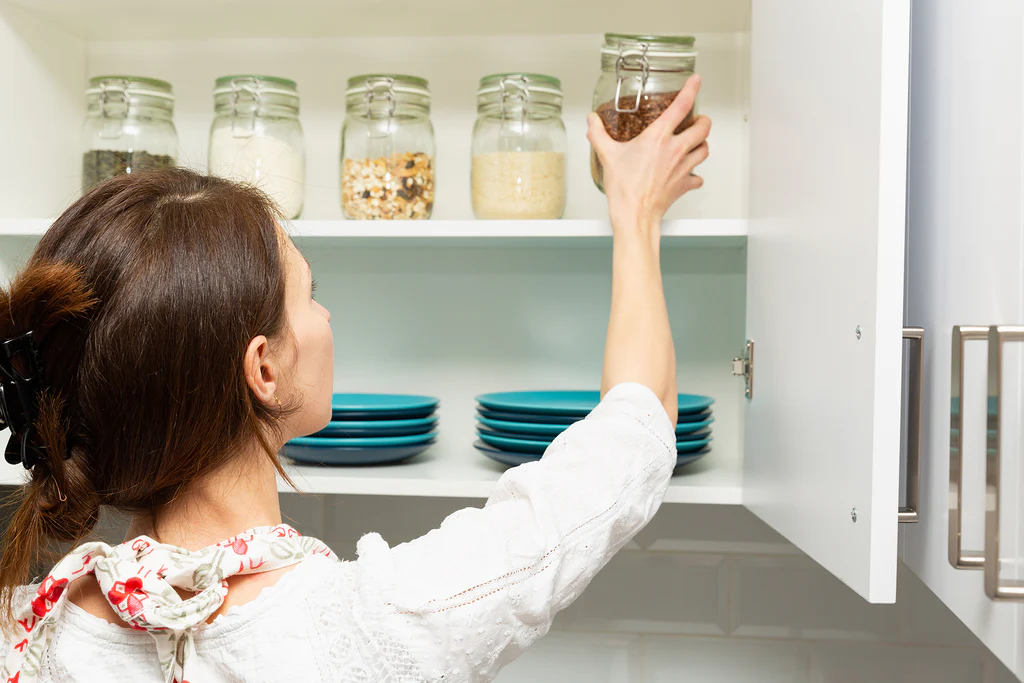
It is necessary to keep the space in the cabinets neat and tidy for a well working kitchen. Shelf risers are a great way to organize your dishes and keep them at reach. Adding small accessories such as a spice rack or a magnet strip can clear up space all throughout the room, while saving time cooking.
Countertops can be a nest for clutter. Appliances have an easy time making themselves at home on the counter top, however they don’t actually belong there. Limit the appliances on your countertops to daily use items and store the rest away in your cabinets and cupboards. If you have a hard time picturing your coveted toaster out of eyesight, designate a cabinet for more regularly used items so they are at close reach. Another way to clear up a significant amount of space is to designate the countertops as a mail-free zone. Keep all mail, important papers and documents in a basket or filing cabinet.
For your pantry and larger appliances like the refrigerator and freezer make sure to check the expiration dates on old condiments and other foods. Throw out any expired products, and section out the space for certain food groups, and drinks. You can even limit your carbon footprint by buying bulk goods and reusable vessels. Rearrange the shelves to optimize time and keep daily use foods close at reach. Store your seasonal cookware and kitchen tools on the top shelf of your pantry to clear up more space in your everyday cabinets.
Pro Tip: A label maker will help organize and give everything in your kitchen a home and dedicated space.
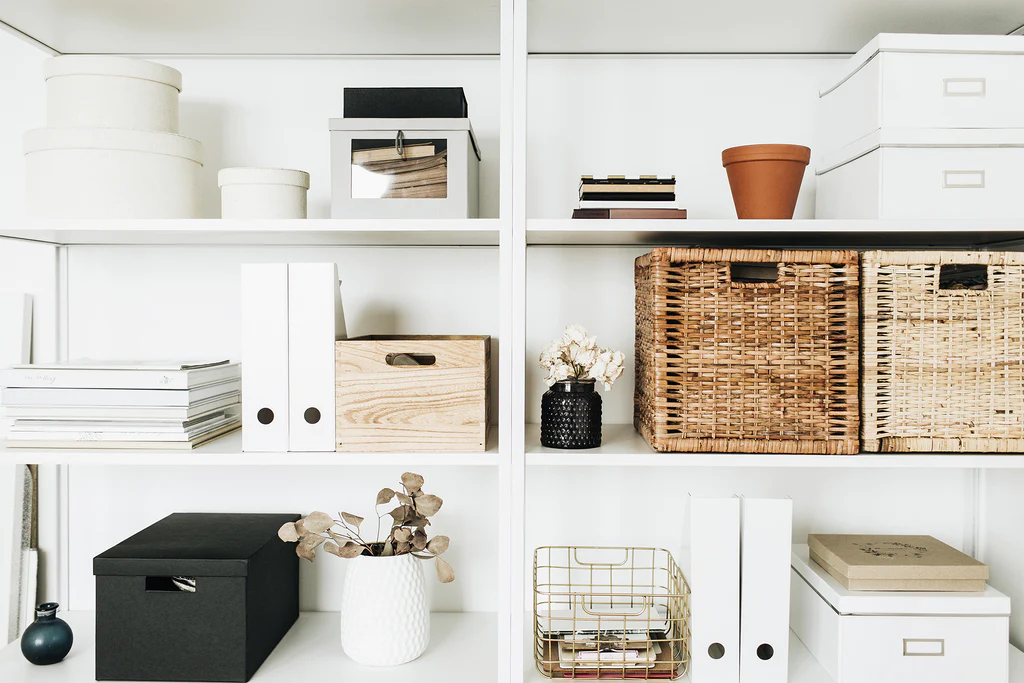
Adding Storage Space
Storage pieces should be stylish and hold a specific group of items to add function to the space. A basket on a shelf in the dining room can hold your favorite seasonal cloth napkins or centerpiece candles, or an antique buffet cabinet can be brought into the living room to help you organize your kids arts & crafts supplies.
Keep bathroom necessities hidden in closed storage receptacles or drawers to streamline the countertops. Use a tray organizer to keep your bathroom drawers neat and tidy. And, if you need more storage—attractive, small cosmetic items can be corralled up on the countertop in clear or ceramic jars.
Hang a few wall hooks for coats or robes in the entryway or mudroom (add small decorative letters or street address numbers from a home improvement store right above the hooks, to identify each family member’s belongings).
Deep Clean As You Go
As you declutter your way through, room by room, take the extra time to give them a deep clean as you work. You’ll be surprised at how a place can look transformed just by a good cleaning. And without the clutter laying around, It makes cleaning a breeze. Grab your favorite eco-friendly cleaning products and start high to low, working your way down from the ceiling to floor. This is the time to wipe down every hard-to-reach corner and scrub away stains that have lived on way too long. Don’t forget to give your sheets, towels, and other every day linens a hot, sanitizing wash.
Pro Tip: Disinfect highly touched surfaces when you’re finished cleaning to eliminate 99.9% of household germs.

Donate Or Give To Friends
Donating and buying usable everyday items (along with sharing and lending them, etc.) are some of the smartest, most effective ways to reduce pollution and preserve your carbon footprint. Donating used goods and materials protects the scarce resources that go into manufacturing, transporting, marketing and ultimately disposing of new goods.
Many people think that donating starts and ends with the closet. We’ll admit it’s the star of the show, and the majority of where clutter lives in most homes, but not the end all-be-all. You’ll be surprised at how much you can find, and donate around the house. A good rule of thumb when donating clothing is: if you haven’t worn something in over a year, it’s time to get rid of it. Make sure anything you donate is clean, in good condition, and usable.
Try the bathroom, and other rooms around the house you normally would not think of, you’ll be surprised at how many items you’ll want to donate, and purge away.
Pro Tip: Animal shelters are always in the need of extra towels, wash clothes, and blankets.
Stopping Clutter Before It Happens
Practice putting items away immediately when you are done using them, before they are set down on a surface where clutter has a chance to grow and multiply. Create and designate a few key clutter-free surfaces in your home, such as your dining table and kitchen counter. This will immediately make your home feel tidier and give you the inspiration and motivation to nip even more clutter in the bud.
Final Rounds
Give yourself an allotted amount of time towards the end of your timer to make a list of anything you did not get to. Go around room by room and take notes of anything that is still left out. Throw out easily small items that you may have missed in your initial sweep, and plan a time and day to go through, and remove larger items and furniture.

Other Helpful Decluttering Tips
- Pare down to what you really need and have room for before you attempt to organize it.
- Take the 12-12-12 challenge. Locate 12 items to throw away, 12 to donate, and 12 to be returned to their proper home.
- Take before & after photos of a small area. Choose one part of your home, like your kitchen counter, and take a photo of a small area. Quickly clean off the items in the photo and take an after photo. Once you see how your home could look, it becomes easier to start decluttering more of your home.
- Check to see if the item still works to determine weather it is trash or not
- Follow the 80/20 rule. Most of the time you only wear 20% of the clothing in your closet, discard of the 80% that is neglected. To identify them, simply hang all your clothes with hangers in the reverse direction. After wearing an item, face the hanger in the correct direction. Discard the clothes you never touched after a few months.
- Track the items you actually use. For example: put a piece of tape on pots and pans and as you use them remove the tape. Any cookware with tape left on it 6 months later can be safe to discard and donate.
- Don’t treat your home like a storage unit
- Stay Organized
No matter which decluttering tip you choose to get started – whether it be one of these or one of countless others – the goal is to take your first step in decluttering your life with excitement behind it. There is a beautiful, happier home and fresh breath hiding behind that clutter.
